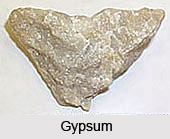 Gypsum, , CaSO4.2H2O, is one of the most important industrial minerals in India.
Gypsum, , CaSO4.2H2O, is one of the most important industrial minerals in India.
Three varieties of gypsum are known namely:
•Selenite
•Alabaster and
•Satin Spar
Selenite is crystalline. It is transparent to translucent. Massive variety is known as alabaster and fibrous or silky variety as satinspar, both pure white to dull white in colour unless otherwise tingled due to impurities. Commercial deposits are mostly found as marine beds. Gypsum is classed under minerals of evaporate group, though vein deposits and massive deposits in the limestone country formed due to interaction of limestone with sulphurous water are not uncommon.
Bedded deposits are found associated with anhydrite (CaSo4, anhydrous gypsum), limestone, shale and clay. Gypsum beds are devoid of fossils. The origin of gypsum has been a subject of great interest in the past and continues to be a research problem for geologists today. As the gypsum directly enters into chemical reaction, the higher the percentage of CaSO4.2H2O content in gypsum the better is the plant performance and the greater is the production of ammonium sulphate.















